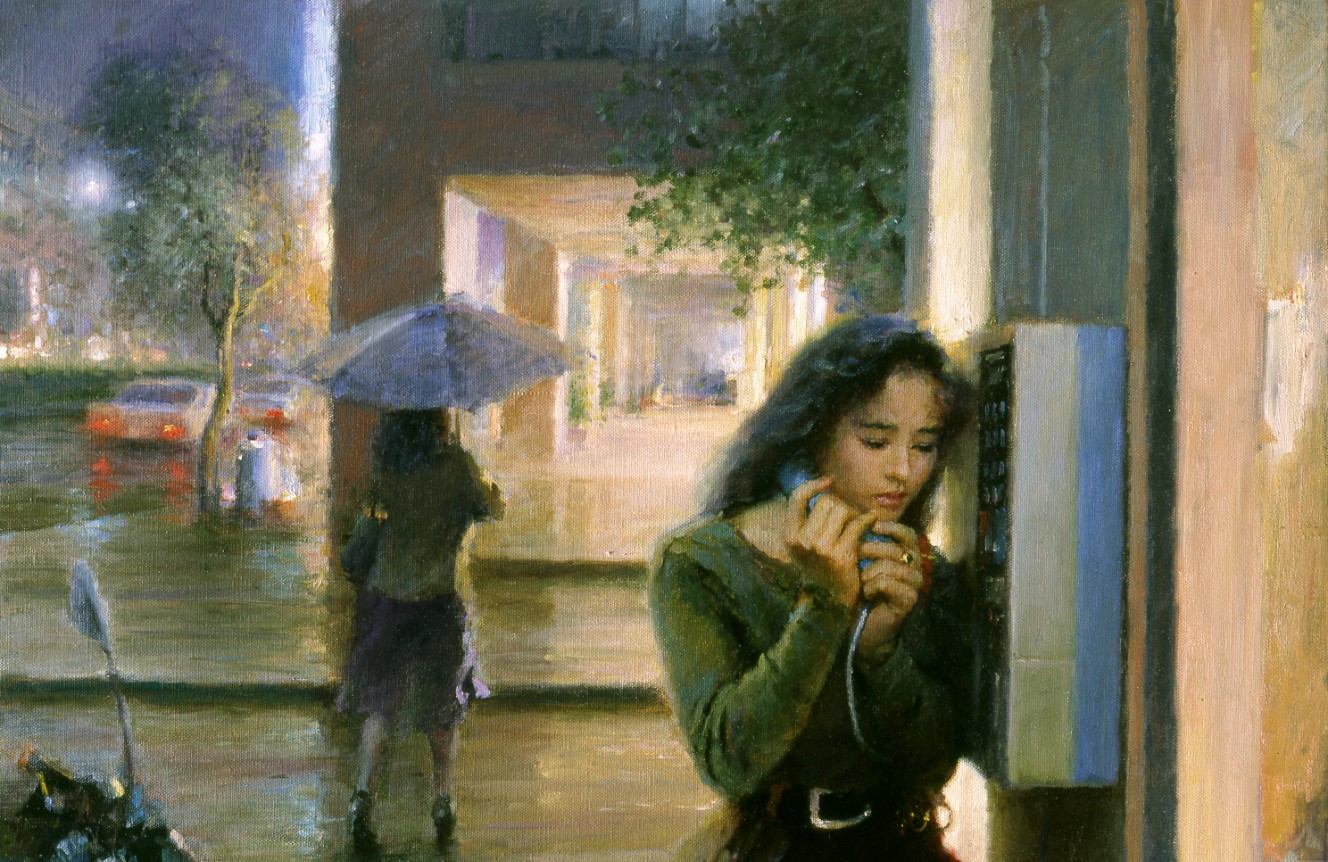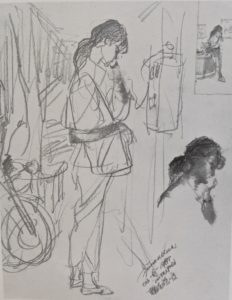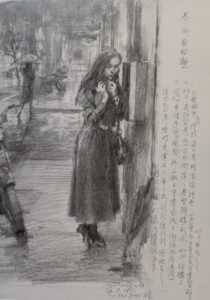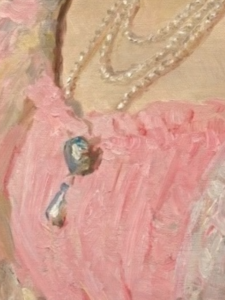Narrative painting is the most challenging genre in realistic art. It’s labor intensive and time consuming. It requires a solid foundation of drawing and sketching and adept portrait painting skills. It’s challenging and painstaking to create a narrative painting but perhaps the most fulfilling once you have the figures and story you have in mind rendered on canvas. I sometimes get questions about how to render ideas on canvas and how to select a subject. In this blog post and the next two, I’m going to share my experience in creating narrative paintings.
如何畫創作畫
創作畫是寫實畫裡最具挑戰性的畫種。不僅勞民傷財,而且需要扎實的素描,速寫和肖像畫基礎。雖然費時費工,畫創作畫,在畫布上一筆筆畫出心中所想也會帶來滿滿的成就感。曾經有畫友問我關於創作畫的問題。接下來的兩篇文章,我會針對創作畫分享我的經驗。
Selecting a subject
There are different genres of narrative paintings such as contemporary, historical, military (battle scenes), religious, fantasy, etc. Inspiration of a narrative painting topic can be from life experience, life observation or simply reading. I have created narrative paintings with contemporary and historical themes, but also stories based on Chinese mythology or literature.
選擇題材
創作畫題材有很多種 – 風俗畫,歷史畫,軍事畫,宗教畫,想像/玄幻。一個畫家選擇繪畫題材有各種因素,教育文化背景當然是重要原因,即文化教育人的傳承,而寫實畫家與周遭生活感受有關。我畫過風俗畫,歷史畫,也有根據中國傳說和文學作品畫過創作畫。
My narrative paintings mostly fall into two categories – contemporary and historical. I like contemporary narrative paintings. They can train my observation and sense of society and it’s easier to find suitable models and backdrop. I created a series of narrative paintings focusing on love stories of young people in Taipei. I use models for reference for characters in contemporary paintings but they don’t necessarily look identical to the model. What I strive to create and render on canvas is an artistic image that embodies what I feel and observe from life, an image not from snapping a photo, but an image that has gone through my imagination, distillation and refinement and is representative of a typical moment under a typical circumstance. More on this later.
我的創作畫大約可以分成兩大類,風俗畫以及歷史畫。我喜歡的風俗畫,它能夠培養我對社會人物和風貌的敏銳觀察和感受,也容易物色到適合的模特兒和典型的環境。所以我在台北創作了不少都市青年感情生活的風情畫。我的風俗畫中的人物通常用生活中的人物作模特兒,經過再創作才有真實感和典型性。創作美感典型,又有生活化的藝術形象是我的努力方向。我希望觀眾會感動,會記住這些形象。
I also like historical paintings which present a challenge to the artist’s understanding of historical characters and they psychology. My historical paintings present the mood and feelings of historical characters of a specific moment in history, leading the audience to explore and understand further these characters and their history. For example, the death of Consort Yang Gui Fei of the Tang dynasty is a well-known story among all Chinese. But the moment of her death at Mawei Courier Station is of particular interest to me. It’s a turning point in Chinese history. What the main characters, Consort Yang, her maid, Gao Lishi, General Chen Xuanli, experience at that moment gave me a lot of room for imagination to recreate the moment. I chose to employ chiaroscuro to reenact the historical moment to reenforce the dramatic effect. The entire process including research, going back and forth between different composition and color studies took me ten years.
我也喜歡畫歷史畫,它挑戰畫家對歷史、歷史人物的理解深度及考驗畫家對歷史人物、情節的心理刻劃。 我的人物創作傳達了歷史的片斷中的人物的心情喜怒哀樂。使觀眾對歷史及其人物有多一層的思索,又多一層理解。例如楊貴妃之死。其實,中國人都知道這段歷史,但是,對馬嵬坡那悲劇的一晚我特別有想像力挑戰的召喚,這一召就畫了十年!經營那一晚的貴妃、高力士、謝阿蠻、將軍、宮女在那一刻,引人感慨殊深,唐代歷史中段在此戛然而止,它吸引我去想像、創作這一幕。尤其是以寫實光影來塑造歷史環境和歷史人物,這種種思考引出作者的選擇和步步挖掘。
For someone first trying out narrative painting, I would suggest starting with a contemporary theme. You can find inspiration based on observation of your life and people around you. It’s easier to conduct research on the selected topic and also find someone to model for your painting for composition and studies.
對於剛開始嚐試畫創作畫的人,我建議從風俗畫開始。風俗畫相對而言比教容易入手。可以從觀察生活的人事物中找題材。蒐集素材和找適合的模特兒都比較容易。
Composition
When you are brainstorming on the composition of the painting, ask yourself the following questions:
- Who including how many, gender, age, characteristics?
- Where and when?
- What are they doing?
- How do they do it?
構圖
創作畫畫面要解決
- 什麼人?(多少人)
- 在哪裡?什麼時間?
- 做什麼?
- 怎麼做?
By answering these questions, what I’m trying to create is a typical character/image under typical circumstances pertaining to the theme.
German philosopher Friedrich Engels said, “realism, to my mind, besides truth of detail, the truthful reproduction of typical characters under typical circumstances.” The keywords in this definition are: Truth, Typical Circumstances and Typical Image.
恩格斯給文學、戲劇中的現實主義下了一個經典性的定義:“據我看來,現實主義的意思是除了細節的真實外,還有真實地再現典型環境中的典型人物。"這個定義中關鍵的詞是:真實、典型環境、典型形象。
Truth – This is the primary difference between Realism and other schools of art. If we look at the paintings espousing Christian dogma by Rubens, Poussin and David during the Classical period, none of them fits the description. Neither does Delacroix and the Romanticism movement. These early great masters all had an amazing eye for detail, but their characters were not real, and the settings were imaginary too. The painting The Spinners by the 17th century Spanish master Diego Velazquez is surprisingly a classic example of Realist art. Here we can see how almost all portraits from the Renaissance through to the 19th century were Realist paintings, perhaps because this genre was not constrained by the environment and had to depict the subject in a truthful manner.
真實 – 這是現實主義與其他藝術流派不同的首要之點,我們回頭看古典主義時期的宣揚基督教教義的繪畫,魯本斯的作品,以及普珊、大衛,當然都不是,浪漫主義,德拉克洛瓦也不是,這些早期大師都有真實描繪細節的本領,但人物是不真實的,環境亦是虛構的。西班牙十七世紀的大師委拉斯蓋茲的《紡紗女》卻出奇地成為經典的現實主義作品。可是,我們發現在肖像畫的領域來看,從文藝復興直到十九世紀幾乎都是現實主義的,因為這個畫種可以擺脫環境的束縛,又都必需追求被描繪對象的真實所至吧。
Typical Image – The creation of the artistic image is the mission of art. The creation of a typical artistic image is the holy grail in Realism. An artist imbues the artistic image he creates with his thoughts and feelings. The artistic image is both the carrier of thoughts and feelings as well the purpose of artistic behavior. The artistic image must be generalized and representative. It must also make a deep and unique impression to be considered typical. Be it literature, theater, painting or mystics, artists are always striving to create a moving and unforgettable artistic image.
典型形象 – 要塑造藝術形象是所有藝術的命題,要塑造典型的藝術形象更是現實主義標舉的目的。藝術家的思想、情感都寄託在他所創作的藝術形象之中,藝術形象是思想、感情的載體,也是藝術行為的目的本身。藝術形象要有概括性,又要有代表性,還要有令人印象深刻的特殊性,這樣才具備典型意義。不管是文學、戲劇、繪畫和音樂,藝術家無不以創造令人難忘又感動的藝術形象為己任。
Typical Circumstances – The subject of Realism is people engaged in activity. If the character must be a typical image, then the character’s surroundings must be reasonable and well-suited to that character, and chosen because it represented the typical circumstances of that character.
典型環境 – 現實主義的表現主體是人,是行為中的人物。要求人物是典型形象時當然地就要求這人物所處的環境是合理的、適合的、絕配於人物的,是經過選擇的也就是典型的環境。
For example, in my painting Spring Drizzle in Taipei, I first got the inspiration of the painting in 1987 when I first went to Taipei. I did a sketch of a young girl making a phone call using a public paid phone in the streets. Then I noticed that public paid phone on the wall was in the streets everywhere in Taipei and often used by young people. If you pay attention, you will catch a glimpse of a poetic scene. I had the idea of doing a painting of a young woman making a phone call in mind for a few years. Then one night in 1992, when I was walking alone on a sheltered sidewalk (which is quite common in Southern China because it rains often) on Zhongshan Road in Taipei, it dawned on me that this should be backdrop of the painting – a sheltered side walk commonly seen in Taipei, public paid phone, spring drizzle, street lights, car lights and a motorcycle (motorcycles are commonly seen in Taipei as a popular transportation mode, particularly for young people). I hired two models for sketching for the young woman in the painting and did sketching and took photos of the backdrop and also motorcycles for the composition.
例如,在【台北春雨夜】中,我1987年住台北重慶南路三段時,有一次在黃昏細雨中畫了一幅站在街邊打電話少女的速寫。後來發現台北到處都設有這種掛立式公共電話,而青年男女使用最普遍。稍加注目,常會出現有詩意的畫面。因而以此作畫的意識一直藏在大腦皮層的皺褶裡。1992年某個雨夜,獨行於中山北路的街邊騎樓時,零感倏忽而降;打電話的女孩應該在這裡打。典型的台北騎樓,春雨,昏燈,車燈倒影,雨傘,電話。只有那摩托車有些不搭調,不過那是請不走的騎樓之客啊!
A few things to keep in mind
畫創作畫要點
Theme of the painting
The theme or story of the painting should be easy to understand. There should be no guessing for the viewer.
主題
主題要清楚,不需要觀眾去猜。
Composition
Sketch your composition ideas on drawing paper. It may take a few attempts before you find a satisfactory composition that conveys your idea.
Divide the sketch into squares. Divide a canvas of the same proportion into squares. Transfer the sketch on the drawing paper to the canvas. You may want to do a color study/color studies on smaller canvas to study relationship of color blocks before transferring the sketch to full size canvas.
構圖
先在素描紙上完成的作品打格子。
在油畫布上等比例打格子。
將素描紙的圖,搬到油畫布上,一比一的比例。
在大畫布上作畫前,最好在小畫部上打彩色稿,釐清色塊關係以及全畫色調。
Details
Key to rendering a typical image under typical circumstances are details. Just like in a movie or TV drama, costume, props and setting help transport the audience to a different world, these details are equally important in a narrative painting to help convince the audience and convey the theme or subject matter of the painting. Details should be suitable for the subject, setting and the period and should be carefully studied. Field trips, reference photos and models are all helpful in creating convincing details.
細節
表達典型環境中的典型型像需要細節去鋪陳。就如服道化和場景於電影和電視劇的重要性,創作畫也需要這些細節來充分表達主題。細節必需符合畫中所表達的主題,典型形像以及典型環境。這些細節可以透過找資料,田野調查,拍照以及雇用模特兒來完成。
In the next blog post, I’m going to share with you the painting process of one of my narrative paintings Taiwan Forefathers Series – Arrival Shore in details.
接下來的兩篇文章我會分享畫【先民渡海 – 抵岸】的過程,供大家做參考。












Thank you very much for the informative blogpost.